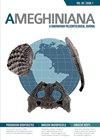Santacrosis前种和Santacross后种Protypotherium的系统订正(Interatheridae,Notoungulata)
IF 1.5
4区 地球科学
Q3 PALEONTOLOGY
引用次数: 0
摘要
摘要Interatheriidae(晚古新世-晚中新世)被认为是南美洲本土有蹄类动物中最多样化和最丰富的分支,在Notoungulata目中,Interatheriidae(晚古新世-晚中新世)是最著名和最具衍生性的科之一。大多数类间恐龙是在19世纪晚期从多产的圣克鲁斯组(Santacrucian SALMA;burdigian -早期Langhian),圣克鲁斯省(阿根廷)。由于其多样性和广泛分布于玻利维亚、智利、乌拉圭,特别是阿根廷,原始兽类是最重要的类间类之一。原兽门上一次被修订是在一个多世纪以前,当时大多数物种被认为是交错兽门(Typotheria incertae sedis)。最近,由不同的作者在这个属中建立了几个种。这一贡献提供了对圣塔克鲁前和圣塔克鲁后的protopotherium物种的分类修订,但不包括那些最初由Florentino Ameghino竖立的物种。我们将P. sinchairi和P. concepcionensis分别作为P. columnifer和P. colloncurensis的初级同系物,并得出结论认为,P. protopotherium包括P. antiquum、P. australe、P. praerutilum、P. compressidens、P. claudum、P. columnifer、P. minutum、P. distinctum和P. colloncurrensis。最后,我们提出了最完整的系统发育分析的Interatheriidae,在属和种水平。由于Caenophilus嵌套在该属内,因此没有恢复protopotherium作为一个分支,并表明该组合是由Deseadan Progaleopithecus和Archaeophylus组成的分支的姐妹分类单元。Resumen。原棘球蚴病,考虑到棘球蚴病más丰富的南美棘球蚴病,Interatheriidae (Paleoceno tardío-Mioceno Tardío),无科棘球蚴病más及其衍生物。《关于个人间通讯通讯的报告》(mayoría)描述了关于个人间通讯通讯的报告(19)、《关于个人间通讯通讯的报告》(especímenes)和《关于个人间通讯通讯的报告》(prolífera Formación Santa Cruz) (Edad Mamífero Santa Cruz;Burdigaliense-Langhiense temprano),省圣克鲁斯(阿根廷)。在玻利维亚、智利、乌拉圭,特别是阿根廷,都有不同种类的原孢子虫(Uno de los interatacridos más重要的原孢子虫(protopotherium)、debido和sudiversidia distribución。对于女性我们天涯一旦hace mas的Protypotherium fue revisado联合国siglo y拉格兰mayoria de las especies fueron consideradas Typotheria incertae基准。Más接收,多样化的autores和erigigdo的各种品种的dendeneste - sameto。Esta contribución目前的la revisión taxonómica的所有种类的原卟啉的前三个月的时间,不包括所有的aquacimllas和fueronerigidas和Florentino Ameghino的dentro del cmacenro。参考文献1 .本文分别研究了本文章由计算机程序翻译,如有差异,请以英文原文为准。
Systematic Revision of Pre- and Post-Santacrucian Species of Protypotherium (Interatheriidae, Notoungulata)
Abstract. Within the Order Notoungulata, considered the most diverse and abundant clade of South American native ungulates, Interatheriidae (late Paleocene–Late Miocene) is one of the best-known and most derived families. Most of the interatheriids were described during the late 19th century from specimens collected from the prolific Santa Cruz Formation (Santacrucian SALMA; Burdigalian–early Langhian), Santa Cruz Province (Argentina). One of the most important interatheriids is Protypotherium due to its diversity and wide distribution in Bolivia, Chile, Uruguay, and, especially, Argentina. Protypotherium was last revised more than a century ago, with most of the species considered Typotheria incertae sedis. More recently, several species were erected within this genus by different authors. This contribution provides the taxonomic revision of the pre- and post-Santacrucian species of Protypotherium, excluding those originally erected by Florentino Ameghino. We propose P. sinclairi and P. concepcionensis as junior synonyms of P. columnifer and P. colloncurensis, respectively, and conclude that Protypotherium includes P. antiquum, P. australe, P. praerutilum, P. compressidens, P. claudum, P. columnifer, P. minutum, P. distinctum, and P. colloncurensis. Finally, we present the most complete phylogenetic analysis of Interatheriidae, at both genus and species levels. It does not recover Protypotherium as a clade due to the nesting of Caenophilus within the genus and shows that this assemblage is the sister taxon of the clade constituted by Deseadan Progaleopithecus and Archaeophylus. Resumen. Dentro del Orden Notoungulata, considerado el clado más diverso y abundante de ungulados nativos de América del Sur, Interatheriidae (Paleoceno tardío–Mioceno Tardío) es una de las familias más conocidas y derivadas. La mayoría de los interatéridos descritos a fines del siglo XIX fueron erigidos a partir de especímenes recolectados en la prolífera Formación Santa Cruz (Edad Mamífero Santacrucense; Burdigaliense–Langhiense temprano), Provincia de Santa Cruz (Argentina). Uno de los interatéridos más importantes es Protypotherium, debido a su diversidad y amplia distribución en Bolivia, Chile, Uruguay y, especialmente, Argentina. Protypotherium fue revisado por última vez hace más de un siglo y la gran mayoría de las especies fueron consideradas Typotheria incertae sedis. Más recientemente, diversos autores han erigido varias especies dentro de este género. Esta contribución presenta la revisión taxonómica de las especies de Protypotherium pre y postsantacrucenses, excluyendo aquéllas que fueron erigidas por Florentino Ameghino dentro del género. Se propone a P. sinclairi y P. concepcionensis como sinónimos junior de P. columnifer y P. colloncurensis, respectivamente, y se concluye que el género está integrado por P. antiquum, P. australe, P. praerutilum, P. compressidens, P. claudum, P. columnifer, P. minutum, P. distinctum y P. colloncurensis. Finalmente, se presenta el análisis filogenético más completo de los Interatheriidae, en términos del muestreo de géneros y especies. Éste no recupera a Protypotherium como clado, debido a la anidación de Caenophilus dentro del género, y muestra a este grupo como el taxón hermano del clado constituido por los géneros deseadenses Progaleopithecus y Archaeophylus.
求助全文
通过发布文献求助,成功后即可免费获取论文全文。
去求助
来源期刊

Ameghiniana
地学-古生物学
CiteScore
2.50
自引率
10.00%
发文量
21
期刊介绍:
Ameghiniana is a bimonthly journal that publishes original contributions on all disciplines related to paleontology, with a special focus on the paleontology of Gondwana and the biotic history of the southern hemisphere. Published yearly since 1957, it has undoubtedly become the main palaeontological publication from Latin America. Ameghiniana has recently broadened its editorial board, reorganized its production process, and increased to a bimonthly frequency, which resulted in a significant decrease in the turn around time.
 求助内容:
求助内容: 应助结果提醒方式:
应助结果提醒方式:


